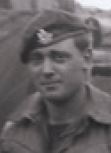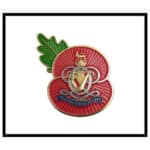Ken was born on the 17th December 1929 at Webbington in Somerset and after schooling was employed as a Market Gardener.

His military service started when he was called up as a National Serviceman on the 21st of April 1949 and posted to The 8th Royal Tank Regiment at Catterick where he trained as a wireless operator, which was completed on the 18th of August 1949.
He was posted to ‘B’ Squadron of The 8th Hussars, the Royal Armoured Corps Demonstration Squadron at the School of Infantry, Warminster in Wiltshire. ‘B’ Squadron under the command of Major W Nelson was equipped with Comet tanks and heavily committed to tank firepower demonstrations and various tactical exercises/demonstrations for the School students. Ken was a Comet wireless operator during these activities.
In the mid-1950 North Korea crossed the 38th Parallel and invaded South Korea and at the request of the United Nations, the Government decided to send the 29th British Independent Infantry Brigade Group from the UK to join the United Nations Forces in Korea. The 8th Hussars were allocated to the 29 Brigade as the Armoured Regiment equipped with Centurion Mk 3 Main Battle Tanks.
Ken, as a National Serviceman was ineligible to go with The 8th Hussars to Korea as his National Service would finish on the 21st of April 1951 permitting him to serve approx. three months in the country.
Ken however was most keen to serve operationally with his ‘B’ Squadron colleagues so on 24th August 1950 he signed on as a ‘K’ Force volunteer for the duration of The 8th Hussar’s service in Korea.
In late 1950 Ken sailed with The 8th Hussars on the Empire Fowey to Korea. Ken became the Driver Operator on ‘B’ Squadron’s two-seat Daimler Scout Car, known as a ‘Dingo.’ It was wheeled, lightly armoured and the driver’s seat was welded to a thirty-gallon fuel tank so it certainly was more vulnerable to enemy action than the crews in their 54-ton Centurions.
For a time Ken drove Captain Roland Wynne, in his duties as a liaison officer. In the spring of 1951 ‘B’ Squadron was located on the southern bank of the River Imjin and patrolled across the Imjin with the Infantry Battalions to dominate no man’s land. Ken often crossed the Imjin in his scout car as part of ‘B’ Squadron Headquarters.
In late April 1951 ‘B’ Squadron handed over to ‘C’ Squadron who were immediately committed to the Battle of the Imjin.
After the Battle, ‘B’ Squadron reoccupied ‘Mistletoe Orchard’ and resumed patrolling over the River Imjin in which Ken was fully occupied. After the formation of the 1st Commonwealth Division in the summer of 1951, it was decided that the Commonwealth Division frontage should be extended north about five miles over the River Imjin to straighten the United Nation’s line.
This was known as ‘Operation Commando’ and took place early in October 1951. ‘B’ Squadron’s role was to support the 3rd Battalion of the Royal Australian Regiment (3 RAR) in attacking and holding Hills 238, 199 and the dominant feature Hill 317.
Ken then moved to 4 Troop commanded by Lt.CA Coldrey as a Centurion wireless operator who was involved in successfully climbing the very steep slopes of Hill 199. Here they gave covering fire to 3 RAR’s successful assault on Hill 317 ignoring the Chinese intense mortar and artillery fire.
Later 3 RAR handed over Hill 317 to the 1st Battalion of The Kin’s Own Scottish Border. (1KOSB) On the night of the 5th November 1951, the Chinese launched a massive attack on Hill 317 and 4 Troop with Ken, on Hill 199 again came under tremendous Chinese artillery and mortar fire.
This did not deter 4 Troop’s maximum 20 Pdr HE support using the ‘artificial moonlight’ provided by the Royal Artillery. The Chinese advanced through the Commonwealth Divisional fire power and their own artillery and mortar fire to retake Hill 317. During this activity 4 Troop were about 1,000 yards from the area where 1 KOSB Pte Speakman’s incredible actions resulted in the award of the Victoria Cross.
Ken left Korea with The 8th Hussars in mid-December 1951 on MV Georgic and arrived at Liverpool on the 15th of January 1952. After disembarkation leave, Ken was demobilised on the 1st March 1952. He carried out two annual fortnightly training periods at firstly the RAC Depot at Bovington and secondly at 4 RTR at Tidworth prior to discharge from the RAC Reserve.
He married Jean Irene Howell on the 28th March 1953 and they had two children, living in Somerset. Ken joined Melhuish and Sanders a Somerset Building Contractor, successfully rising from a bricklayer to become a Site Manager.
He was a keen, proud and interested member of The Queen’s Royal Hussars Regimental Association and an active committee member of the Somerset and Avon Branch of the British Korean Veterans Association. His hobbies included collecting mineral samples and coins, with a series of farthings, reaching back as far as AD 1600.
Sadly Ken died on the 24th of January 2007 and was buried, joining his parents, in Compton Bishop Churchyard in Somerset.
When remembering Ken, two military adages come to mind, firstly ‘There is only one thing worse than being in action, that is being out of action when your Squadron is fighting.’ Ken did not have to go to Korea but signed on to be with his fellow soldiers.
Finally, it is stated ‘There is only one redeeming feature about going to war and that is you will meet some very nice people.’ How true this is in regard to Ken.



